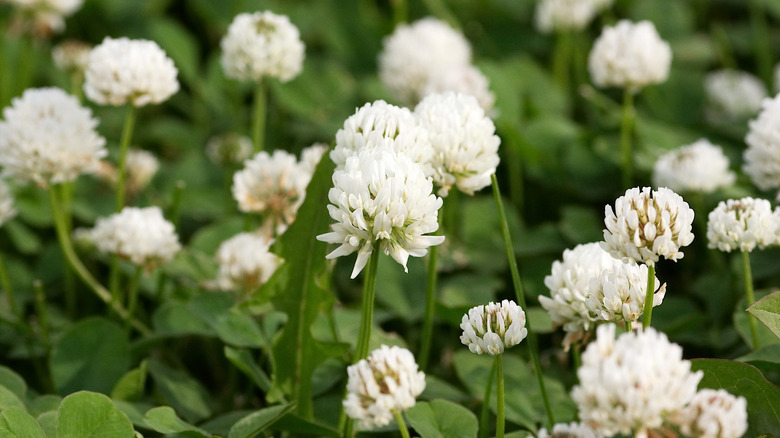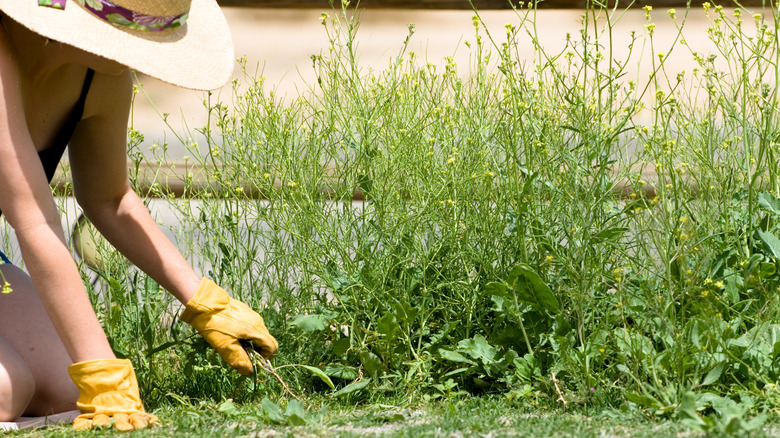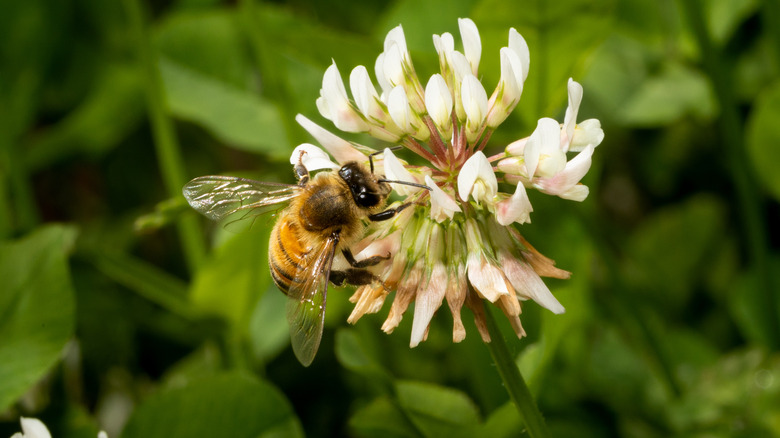The Easy Way To Prevent White Clover Weeds From Taking Over Your Lawn
If you have a lawn, you know that keeping it lush and green requires planning. The idea that grass can thrive with a hands-off approach is a lawn care myth that people need to stop believing. From watering to mowing, there's a lot to consider, but perhaps the most challenging aspect is keeping weeds at bay. There are as many as 30 common garden weeds just waiting to take over your beautiful lawn and how you get rid of these weeds very much depends on which one is giving you trouble.
If you think you're dealing with white clover, you can easily identify it by its three-lobed leaves marked with a distinctive white "V," as well as its round white and pinkish flowers. This perennial can spread quickly, forming dense mats up to 12 inches wide and 10 inches tall, so prevention is key. Luckily, this can be achieved easily enough by paying close attention to your soil and grass. More specifically, a combination of nitrogen-rich fertilizer and high mowing is the simple key to stopping white clover from taking over your lawn.
How to banish white clover weeds for good
There are a handful of reasons why white clover may pop up on your lawn, but low-nitrogen soil tops the list. This perennial gets its nitrogen directly from the air, so unlike other plants, which rely on nitrogen-rich soil to survive, it will thrive in spots with waning nitrogen levels. In order to prevent this, simply use a nitrogen-rich liquid fertilizer to make the ground inhospitable to white clover but welcoming for other flora. What's more, if you do see it starting to sprout anywhere, you can apply some nitrogen-rich fertilizer directly on top of the plant to banish it for good.
Proper mowing is also important. Rather than trimming grass nice and low, raise your mowing height to 3 inches or more. This leaves you with beautiful long blades that cast plenty of shade onto white clover's shallow roots and stop the weed from growing.
Another tried-and-true option is covering your lawn with a thick layer of mulch, which stops sunlight reaching any potential clover seeds, thus stunting their growth. Finally, ensure your soil's pH is between 6 and 7. When your ground is too acidic (0 being the most acidic it can be), white clover will thrive. Adding lime to the soil should solve this problem. You'll also want to avoid using a core or spile aerator, as doing so could compact your soil.
Other ways to get rid of white clover (and why you might not want to)
If your prevention efforts haven't worked perfectly, there's still plenty you can do to banish this resilient weed from your grass. If you've spotted it early enough and it's only visible in a few spots, you can pull it up by hand, then loosen the soil in the area to break up any leftover roots. On the flip side, if it's already grown out of control, a liquid weed killer concentrate should do the trick.
And while it may seem counterintuitive, especially since we've just outlined how to eliminate white clover, you may actually want to let it flourish. This perennial comes with a number of hidden benefits and there are some things you should consider before getting rid of it. For one, the plant absorbs nitrogen from the air and redirects it into the soil, which means it acts like a natural fertilizer for your grass. This, in turn, helps promote a lush lawn. And because it's such a resilient weed, clover can actually stop more harmful weeds from growing in its vicinity and taking over your green space.
While clover also has aesthetic upsides. Even if you don't particularly like its look, it thrives in the driest of environments and can compensate for any brown patches in your lawn during sweltering summer months. Not to mention it can play an important role in your local ecosystem, as it's a favorite among pollinators and helps maintain healthy honeybee populations.



